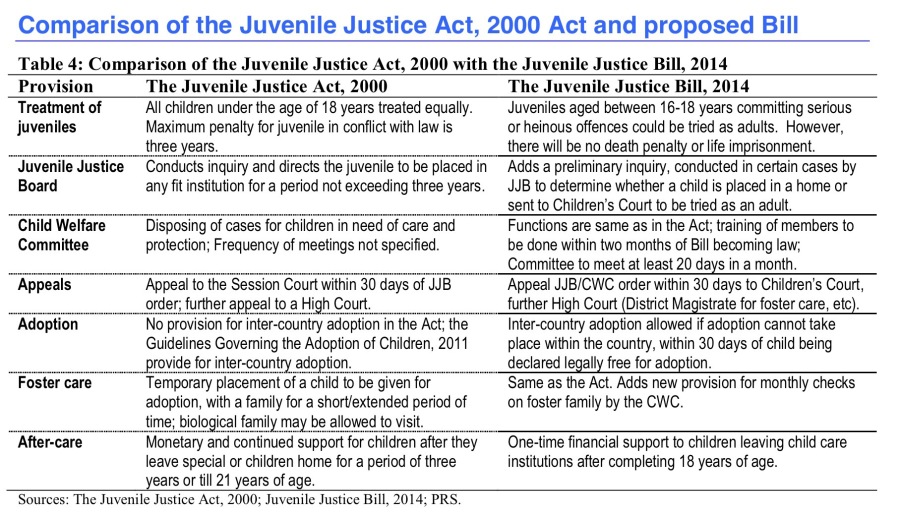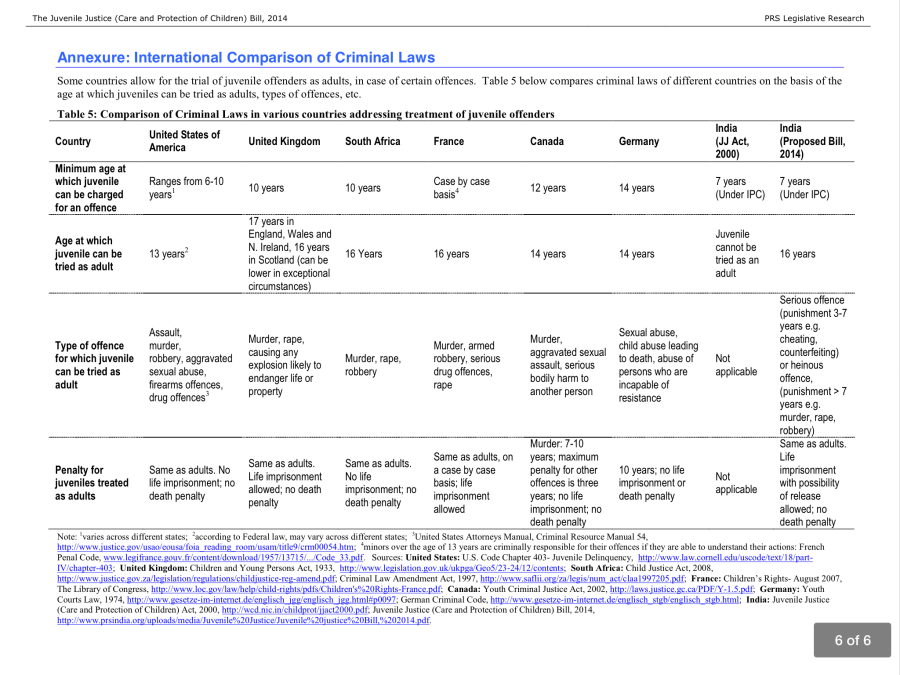Rajya Sabha has recently passed the Juvenile Justice bill, 2015 to amend the Juvenile Justice Act, 2000. This article will focus on analysing the conflict arose between Juvenile Justice and Justice to Victims. For other provision (such as relating to Child welfare committees (CWCs)) of this JJB, 2015 you can refer to PRS legislative brief here.
There are following three principles or aspects of Natural Criminal Justice or simply justice that need to be remembered to analyse any type of law:-
- Justice to victim
- Punishment should act as a deterrent so that crimes actual number reduces.
- Justice which is rehabilitative to the criminal or convict so that he doesn’t commit the crime again. And ultimately we have reduced number of crimes in society. Also rehabilitation should facilitate re-entry of criminal to society
Provision of Juvenile Justice (care and Protection of children) Bill, 2015
- Juveniles crime has been categorised into 3 categories as
- Heinous (most severe with minimum imprisonment of 7 years)
- Serious ( imprisonment between 3 to 7 years)
- Petty ( max improvement – 3 years)
- Juvenile Justice board (JJB) will be setup in each district to take case of offences done by persons below the age of 18 years.
- For heinous crimes, a juvenile aged between 16 and 18 years could be sent to Children’s court to decide whether to try juvenile as an adult based on the preliminary inquiry done by JJB. JJB will try to asses the mental/physical development of juvenile. It would also assess whether the juvenile was aware of the consequences of his/her act.
- The bill makes a distinction between the age when crime is committed and the age on date of apprehension. For example, the cases which fall in serious crimes categories, the juveniles aged between 16 to 18 years could be tried as adult if they are apprehended after 21 years otherwise as juvenile.
- Similar distinction is being done in heinous offences as well. For details you can refer to table below.

Following tables (from PRS Legislative brief) compares the provision in Juvenile Justice, 2000 Act and proposed bill

So Should the Juveniles aged between 16-18 years be tried as adults?
Yes –
- Principle of Criminal Justice System apart from providing reforming or rehabilitative justice should also look at principles of justice to victim and punishment to act as deterrent. So if harsh punishment is given to juvenile charged of heinous/serious crime is given then justice will be served to victim. Punishment will also act as a deterrence.
- Juvenile Justice Act, 2015 doesn’t say that all the juvenile will be tried as adults. It only say that juvenile aged between 16 -18 years who commits heinous/serious crimes would be tried as adults subject to enquiry done by JJB. After the JJB’s enquiry, Juveniles to be tried as adult would be sent to Children’s court which will then finally take a decision to try him as adult or otherwise.
- Data: Juvenile aged between age of 7 and 18 years constitutes around 25% of total population. According to National Crime Records Bureau (NCRB), the juvenile crimes (by 16-18 year old) as percentage of all juvenile crimes have increased from 54% in 2003 to 66% in 2013. Moreover Supreme Court has suggested that 2000 Act has to reviewed as more heinous crimes are being committed by Juveniles.
- If a juvenile (aged between 16-18) commits crime such as Rapes or Murder, it is very hard to ascertain that juvenile was not affair of its consequences.
- In today’s Information Age where children are exposed to sexual/pornographic content at very young age due to Internet and mobile phones. Children are maturing at a much faster rate than they were 10 or 20 years ago. So there is not much difference with respect to mental development between 16 or 18-year-old. However Medical research may be needed to prove this.
No –
- The same NCRB data shows that juvenile crimes as percentage of total crime have marginally increased from 1 % in 2003 to 1.2% in 2013. Moreover the data is based on FIRs record not on actual convictions. So a theory that juvenile crimes are increasing may not be appropriate.
- Our aim of criminal justice is to reform the juvenile and stop them from converting into hardened criminals. If we send juveniles to prison where they are in touch with serious adult criminals, there is very less chance, that they will be able to reform or rehabilitate themselves. In Fact, when realised into society once again after completing their sentence, they might turn out to be a greater danger than before. However this theory than applies to all adult criminals and raises serious questions about the reforming capacity of our justice system.
- India ratified the United Nations Convention on the Rights of Child (UNCRC) in 1992. It requires India to do not differentiate the child under the age of 18 years or try them as adult. If differentiate the juveniles between 16-18 years as adults then we are violating it.
- Distinction made in the bill related to date of apprehension and date of crime being committed, if implemented may lead to violation of Art. 14, 21 and 20(1) of constitution as follows
- Art 14 states every person should be treated equally before the law. Further unequal treatment may be given only when there is some public purpose to be served. So it’s is difficult to qualify date of apprehension as reasonable restriction to award different treatments for same crime.
- Art 21 states that no person should be deprived of his life or personal liberty except as per the lawful procedure. A lawful procedure, as interpreted by court, is a procedure which is fair and reasonable. So differentiation based on the date of apprehension may not be regarded as lawful procedure. Further in 2005, Constitution bench of SC decided that date when crime is committed matters not the date of apprehension.
- Art 20(1) says that person cannot be given greater sentence than the one specified in the law at time of commitment of offence. So in spirit of this article, it is hard to justify that when a crime is committed between the age of 16-18 years,and suppose if apprehension happens after 21 years, then the person would be awarded a severe sentence than the one which had been awarded if he had been apprehended below 21 years of age.
- Juveniles if not improved in Juveniles home or reformed is because of poor implementation of the act. The proper rehabilitation of children is not happening as institution such as Child welfare and selection committee, JJBs, special juvenile police unit are not working according to their mandate.
- The issue is focussed in current scenario because of the release of one of the Juvenile convicted in Nirbhaya’s case. So legislature has let itself been guided by society whims and will for retribution. We cannot base Justice such that it satisfy the victim or his/her family. If we do that then we will soon become a society an eye is demand for an eye and will soon become blind.
- Crimes against women happens because of gender inequity in society which is persistent more in Northern States. So issue should be focused upon removing this gender inequity instead of trying Juviniles as adults.
- It is a misconception in the society that Juveniles are punished, it is just that they are given punishment according to their age, physical and emotional status.
- It is being believed by experts that full development of human brains doesn’t happen till the mid-20s and young adults under peer pressure are unstable in emotionally charged situations. So taking cognizance of this fact, we have to, infact, increase the age of Juveniles from 18 to may be 21.
- Approximately 50% of children in Juvenile home belong to marginalised section of society. So if we allow these amendments then they could lead further marginalisation of these children. These children may not have proper guidance from parents or sufficient education, so they need to be treated properly in Juveniles Homes.I t may also be used against consensual relationship by parents.
Provison in Other Countries

Conclusion
Based upon the analyses the author concludes that
Amendment was necessary in today’s time but provision to treat juvenile as adult should be used sparingly in such a way that further marginalisation of society doesn’t happen and also proper implementation of Juvenile rehabilitation system should be done.
Sources
- PRS Legislative Brief (credits for tables ) http://www.prsindia.org/uploads/media/Juvenile%20Justice/Legislative%20Brief%20Juvenile%20Justice%20Bill.pdf
- http://indianexpress.com/article/explained/simply-put-who-is-a-child-the-16-or-18-debate/
- Feature image credit http://www.pixabay.com